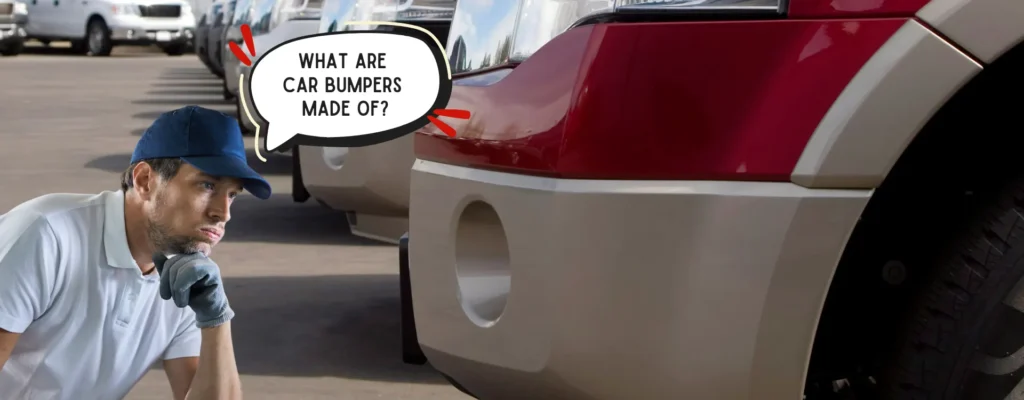
Car bumpers are essential components that absorb impact during collisions and protect both the vehicle and its occupants. Understanding the composition of automobile bumpers can help vehicle owners appreciate their importance and make informed decisions when selecting an auto body shop for installations or repairs.
This blog will explore the various car bumper materials used and the pros and cons of each one.
IN NEED OF A POST- ACCIDENT CAR REPAIR?
The Evolution of Car Bumpers
The bumper system has come a long way since its inception.
In the past, they were merely metal bars attached to the front and rear of vehicles to prevent minor damage. However, as automotive technology advanced, the need for more sophisticated and effective vehicle bumpers became evident. Today, front and rear bumpers are complex systems designed to absorb and dissipate energy during a collision. This significantly reduces the risk of injury to passengers and damage to the vehicle.
What are Car Bumpers Made Of? Types of Material Used
Steel Bumpers
Steel was one of the earliest materials used. Known for its strength and durability, bumpers made of steel provide excellent protection against severe impacts. However, they are heavy, which can negatively affect the vehicle’s fuel efficiency and handling. Steel is also prone to rust and corrosion, requiring regular maintenance to ensure longevity.
Aluminum Bumpers
Aluminum has become a popular material to make bumpers due to its lightweight nature and resistance to rust. While not as strong as steel, aluminum bumpers offer a good balance of protection and weight savings. This material is particularly favored in high-performance and luxury vehicles where weight reduction is critical for improving speed and fuel efficiency.
Plastic Bumpers
Modern bumpers are made of plastic or plastic composites. These materials offer several advantages, including being lightweight, corrosion-resistant, and cost-effective. Common types of plastics used as car bumper material include:
- Polycarbonate (PC): Known for its high impact resistance and transparency, polycarbonate is often used in headlight lenses and bumpers.
- Polypropylene (PP): This is a flexible and durable plastic that can withstand significant impact without cracking or breaking.
- Acrylonitrile Butadiene Styrene (ABS): ABS is a common material used in car bumpers due to its excellent impact resistance and toughness.
Reinforced Plastic
To enhance the strength and durability of plastic bumpers, manufacturers often reinforce them with materials like fiberglass or carbon fiber. These provide the advantages of both lightweight and enhanced structural integrity, making them ideal for high-performance vehicles.
Thermoplastic Olefin (TPO)
TPO is known for its excellent impact resistance and flexibility. It combines the properties of polypropylene and rubber, making it highly durable and resistant to environmental factors such as UV rays and extreme temperatures.
Benefits of Modern Car Bumper Materials
Improved Safety
The primary purpose of rear and front bumpers is to protect the occupants of the vehicle in case of an accident. Modern car bumper structures absorb and dissipate energy, reducing the force of impact and minimizing injury. The use of plastic composites and reinforced plastics enhances this protective capability without adding significant weight to the vehicle.
Cost-Effective Bumper Repairs
Plastic bumpers are generally easier and cheaper to repair or replace compared to their metal counterparts. This makes them a smarter choice for auto owners, especially considering the frequency of minor dents, fender-benders, and the related repair costs.
Aesthetic Appeal
Plastic and composite car bumper materials offer greater flexibility in design, allowing manufacturers to create more aesthetically pleasing installations that seamlessly integrate with the overall design of the vehicle. This not only enhances the look of the car but also contributes to better aerodynamics, which can improve fuel efficiency.
Choosing the Right Collision Repair Center
When it comes to repairing or replacing a car bumper, selecting a professional collision repair center is important. A reputable repair center will have the expertise and equipment necessary to handle various car bumper materials and ensure the repair is done to manufacturer specifications. Here are some tips to find the best collision repair center:
Check for Certifications
Look for repair centers that have accreditations from automotive manufacturers and industry organizations. These indicate that the center meets the high standards required for quality repairs.
Read Reviews and Ask for Recommendations
Customer reviews and recommendations from friends or family can provide valuable insights into the quality of service provided by a repair center. Look for centers with positive feedback regarding their workmanship, customer service, and turnaround time.
Inspect the Facility
Take a tour of the shop to see if they have the tools and technology necessary to handle your vehicle’s specific needs.
Inquire About Warranties
A reliable collision repair center will stand behind their work and offer warranties on repairs. This ensures that you can return to the shop if any issues arise with the repaired bumper.
Ask About the Repair Process
Knowing what to expect can give you confidence in the repair center’s ability to restore your vehicle to its original condition. Ask about the materials they use, their repair techniques, and how they match paint colors.
Find a Reliable Collision Repair Center via Collision Connect
Now that we’ve answered “What are car bumpers made of?” and discussed the benefits of different materials, we hope you can somehow make informed decisions about your vehicle’s repairs.
Whether you need a minor fix or a full replacement, working with the right auto bumper repair shop is necessary to guarantee your vehicle’s safety and maintain its aesthetic appeal.
Collision Connect connects car owners with top-rated collision repair centers all over California. Our platform makes it easy to find a reliable repair shop that meets your needs and budget. Don’t leave your car’s safety to chance — find the best collision repair center near you now.
Offering bumper repair services in CA? Click here to list your shop.
IN NEED OF A POST- ACCIDENT CAR REPAIR?